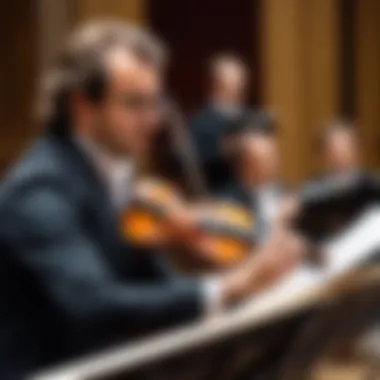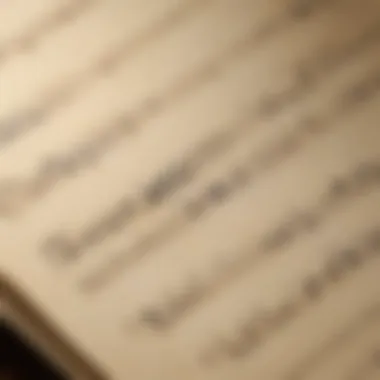The Impact of Antoine Bayet on Frederique's Quartet


Intro
Antoine Bayet's contributions to chamber music are significant and noteworthy. His work has resonated widely, influencing many musicians. This article aims to explore how Bayet's techniques shape the composition and interpretation of Frederique's Quartet. By delving into Bayet's methodologies, and stylistic choices, the analysis sheds light on the broader spectrum of chamber music.
Bayet's approach intertwines traditional elements with innovative techniques. Understanding his influence enhances the appreciation of Frederique's Quartet, revealing connections that go beyond the surface.
The Context of Bayet's Musical Career
Antoine Bayet emerged during a time of shift in musical tastes. The late 19th and early 20th centuries witnessed a surge in experimental compositions. Bayet's work not only mirrored these changes but also contributed to them. He utilized harmony, rhythm, and form in ways that questioned established norms, setting a foundation for future composers.
Key Contributions to Chamber Music
Bayet's chamber works, particularly quartets, introduced new dynamics. His compositions explore a wide palette of emotional depth. Elements such as tension, resolution, and interplay among instruments define his quartets. This approach invites musicians and listeners to engage deeply with the music, fostering an intimate understanding.
Stylistic Elements
Exploration into his stylistic elements reveals distinct patterns:
- Melodic Development: Bayet's melodies often evolve throughout the piece, creating a sense of journey.
- Harmony: Complex harmonic structures provide rich textures, inviting varied interpretations.
- Rhythm: An innovative rhythmic approach shapes the musical narrative, enhancing the listener's experience.
Bayet's ability to blend these elements results in compositions that resonate with both performers and audiences.
Frederique's Quartet and Bayet's Influence
Frederique's Quartet stands as a testament to Bayet's influence. Each member of the quartet brings their interpretation, creating a mosaic of sounds. Yet, the foundation laid by Bayet is evident in their performances.
Thematic Concerns
Bayet's thematic concerns, centering on love, nature, and human experience, resonate in Frederique's Quartet. The music captures the essence of these themes through rich harmonies and engaging melodies. This thematic crossover enriches the listening experience, allowing for reflective moments in performances.
Reception within the Classical Music Community
Bayet's works initially met with mixed reactions but have gained appreciation over time. His unique qualities set him apart in the classical music landscape. The acceptance of his style influences newer generations, especially those interpreting Frederique's Quartet.
Finale
Antoine Bayet's impact on Frederique's Quartet is multifaceted. By understanding his innovations and thematic elements, one gains insight into the beauty of chamber music. This exploration serves to honor Bayet’s legacy while highlighting its profound relevance today.
Intro to Antoine Bayet and Frederique's Quartet
The relationship between Antoine Bayet and Frederique's Quartet presents a significant area of exploration for those interested in the evolution of chamber music. This section sets the stage for understanding this influence, examining the key aspects that define both Bayet's life and the historical context of Frederique's Quartet.
By analyzing the intricacies of their connection, readers gain insight into how Bayet's unique approach to composition has left an indelible mark on the quartet's structure and thematic development. The investigation into the implications of their interactions enhances appreciation of contemporary chamber music. It also aims to exhibit the cultural significance of this relationship.
Overview of Antoine Bayet's Life
Antoine Bayet, a renowned figure in early 20th-century music, was born in 1884. His upbringing in a culturally rich environment significantly shaped his artistic inclinations. He studied under notable composers, which laid a solid foundation for his innovative musical career. Bayet’s compositions often reflect a deep understanding of emotional undertones and structural integrity.
In his work, we find a commitment to experimentation. He did not shy away from challenging traditional forms. Instead, he sought to create pieces that resonated with both musicians and audiences. His commitment to education also cannot be overlooked. Bayet mentored many aspiring musicians, ensuring that his influence expanded beyond his compositions.
Frederique's Quartet: A Historical Context


Frederique's Quartet emerged in the midst of the evolving chamber music landscape. Established in 1920, it was a response to the shifting artistic currents of the time. The quartet performed many contemporaneous pieces, but it also gravitated toward works by composers like Bayet. This connection highlighted a mutual quest for innovation and emotional depth in music.
The ensemble itself was characterized by its dedication to interpreting both classical and modern repertoires. Their performances often bridged the gap between established norms and progressive ideas. Understanding this context is vital, as it allows one to appreciate how Bayet’s influence would fit within the broader narrative of chamber music during his time.
Notably, Frederique's Quartet helped in promoting lesser-known compositions alongside well-established works. This approach facilitated a richer dialogue about the possibilities within chamber music, laying the groundwork for future generations of composers and quartets.
Antoine Bayet's Musical Philosophy
Antoine Bayet's musical philosophy serves as a cornerstone in understanding his contributions to the realm of chamber music, particularly in relation to Frederique's Quartet. This philosophy is not merely a collection of abstract ideas but a living doctrine that influences the way music is created, interpreted, and perceived. At its heart lies a commitment to blend technical precision with emotional depth, a signature that sets Bayet's work apart from contemporaries. This section explores key elements that underscore the significance of Bayet's philosophy, emphasizing core principles and the balance he achieves between emotion and structure.
Core Principles of Bayet's Compositions
Bayet's compositions are built on a few core principles that manifest throughout his works. Firstly, a strong emphasis on structure is apparent. He meticulously constructs his pieces, allowing each section to serve a specific purpose and contribute to a larger musical narrative. This structural integrity ensures that performances remain cohesive and engaging from beginning to end.
Secondly, Bayet's innovative approach to melody is crucial. He often avoids conventional patterns, opting instead for unexpected melodic turns that challenge listeners while remaining accessible.
Further, he pays meticulous attention to rhythm. The rhythmic variety found in his works reflects a deep understanding of how rhythm interacts with other musical elements, enhancing the overall texture.
Finally, Bayet's philosophy celebrates the use of silence, not merely as a pause in sound but as an integral part of musical expression. This highlights an awareness of space and timing, factors that shape the listener's experience dramatically.
Integrating Emotion and Structure
The integration of emotion and structure is a key feature of Bayet's work. He believes that music should evoke feelings while adhering to a structured form. This is achieved through contrasting sections within his pieces. For example, a lively, rhythmic passage may be followed by a more introspective melody, creating a profound emotional journey.
Bayet often harnesses dynamic contrasts to heighten emotional impact. This dynamic layering not only captivates the audience but also invites them to reflect on their own emotional responses.
Moreover, his use of thematic development allows him to deepen emotional resonance throughout a piece. By revisiting and transforming themes, he builds a narrative that unfolds over time, engaging listeners and offering them a sense of progression.
In summary, Antoine Bayet's musical philosophy, as evidenced through his core principles and unique approach to emotion and structure, plays a vital role in his influence on Frederique's Quartet. Understanding this philosophy provides insight into how his works continue to resonate within the chamber music landscape.
The Stylistic Features of Frederique's Quartet
Understanding the stylistic features of Frederique's Quartet is crucial to appreciate the depth of Antoine Bayet's influence. Frederique's Quartet is not merely a collection of notes; it encapsulates innovative elements that showcase both tradition and modernity. The interaction between melodic and harmonic techniques within the quartet creates a rich tapestry that resonates with listeners.
The stylistic tendencies in Frederique's Quartet can be examined through various lenses—melodic innovations, harmonic language, and the techniques employed by its composers. Each of these aspects interplays to form a sound that pays homage to the past while embracing new ideas. The essence of these stylistic features lies not just in the notes themselves, but in their arrangement and emotional delivery.
Melodic Innovations in the Quartet
Melodic innovations are a hallmark of Frederique's Quartet, reflecting Bayet's impact. He introduced unique melodic lines that evolved throughout the piece. These lines often exhibit patterns of repetition while simultaneously varying in their execution, creating a sense of development and progression.
One notable feature is the use of counterpoint, where independent melodic lines coexist, supporting one another while reinforcing the thematic material. This technique allows for an organic growth of musical ideas, providing a fertile ground for emotional expression. The quartet's melodies often fluctuate between consonance and dissonance, stirring feelings within the listener.
Moreover, the incorporation of folk elements can be traced within the melodies. This blending of styles not only roots the work within cultural context but brings a refreshing authenticity to the music. Such innovation challenges conventional constructs, making it a compelling study in contemporary chamber music.
Harmonic Language and Techniques
The harmonic aspects of Frederique's Quartet reveal a sophisticated palette of sounds that distinguish this work in the chamber music repertoire. Bayet's harmonic language transcends traditional boundaries, employing both diatonic and chromatic harmonies. This creates a richer texture and an overall depth that captivates discerning audiences.
The use of extended chords and irregular resolutions adds unexpected turns to the harmonic journey, often leading to moments of tension and release. This approach encourages listeners to engage more deeply with the music, prompting a contemplative exploration of both form and emotional content.
Additionally, Bayet often employed a modal interchange, shifting harmonies to create a new ambiance. This technique not only adds variety but also offers a nuanced contrast to the existing tonal palette. The harmonic techniques employed by Frederique’s Quartet serve as a testament to how diverse influences can shape modern compositions, all the while preserving a dialogue with traditional forms.


"The harmonic language is where the soul of Frederique's Quartet truly reveals itself, bridging the gap between form and emotion."
Bayet's Contribution to Chamber Music
Antoine Bayet's contributions to chamber music extend far beyond mere compositions; they represent an evolution in the genre’s structure and emotional depth. His innovative techniques have not only enriched the repertoire but also challenged conventional ideas of what chamber music can express. By focusing on specific elements such as his harmonic choices and thematic development, one can appreciate the significance of his work within the classical music landscape.
One of the core benefits of Bayet's impact is his ability to blend traditional forms with modern sensibilities. His quartets often display intricate counterpoint while allowing for rich and varied emotional undertones. This duality makes his music both accessible and intellectually stimulating, appealing to performers and audiences alike.
Bayet's approach also reflects a deep understanding of instrumentation. He wrote with specific consideration of how each instrument can contribute to a unified sound while allowing individual voices to shine through. This level of detail encourages performers to engage with the music critically, leading to interpretations that are both nuanced and vibrant.
"Bayet's chamber works illustrate a masterful balance between precision and expressiveness, resonating with the performers' emotional capacities."
Impact on Contemporary Quartet Composition
Bayet's influence on contemporary quartet composition is readily apparent in various ways. First, his techniques have inspired a generation of composers to experiment with textures and forms. He emphasized moving away from predictable patterns, challenging musicians to think creatively about how they can approach their own compositions.
Furthermore, Bayet's unique voice has led to a resurgence in the popularity of chamber music. His quartets are frequently programmed in concert series and music festivals, enticing new audiences. Composers analyze his works to uncover the methods he employed, thus inspiring new works that echo his innovative spirit.
Collaboration with Other Musicians
Collaboration played a vital role in Bayet's contributions to chamber music. His works often collaborated with notable musicians of his time, resulting in a rich tapestry of musical ideas. Through these collaborations, he absorbed various influences that expanded his compositional palette.
In addition, his willingness to work across genres has led to exciting cross-pollination of styles, enriching the chamber music discourse. Musicians found inspiration in Bayet's ability to adapt and integrate multiple musical influences into his works, fostering a collaborative spirit that resonated widely.
Through these collaborative efforts, Bayet not only shaped his music but also contributed to a larger community of artists aiming to redefine chamber music for contemporary audiences. His enduring impact is evident in the continued exploration of artistic partnerships in today’s musical landscape.
Reception of Bayet's Quartet Works
The reception of Antoine Bayet's quartet works is crucial to understanding his enduring impact in the realm of chamber music. This section focuses on how both peers and audiences have engaged with Bayet's compositions over time. Analyzing the responses from these groups enriches the narrative surrounding Frederique's Quartet and highlights the significance of Bayet's innovations in this genre.
Critical Response from Peers
The critical response to Bayet's works has been characterized by a mix of admiration and scholarly analysis. Critics have often praised his ability to blend traditional techniques with innovative ideas. Notably, publications such as Le Monde de la Musique have highlighted specific compositions that showcase Bayet's unique voice. Some critiques revolve around the emotional depth and complexity found within his quartets, which challenge performers while providing a rewarding experience.
One recurring theme in peer reviews is Bayet's use of counterpoint. This technique has often been acknowledged for its sophistication and has led to comparisons with masters like Ludwig van Beethoven. Critics also note the nuances in harmonic language that engage seasoned musicians and challenge their creative capacities. For contemporary composers, Bayet offers a reference point, as his works continue to inspire and provoke discussion.
Audience Reception Over Time
How audiences perceive music is a dynamic that evolves, often reflecting broader societal changes. In the case of Bayet's quartets, initial reactions were varied, ranging from intrigue to some confusion. As time progressed, audiences began to appreciate his works more deeply.
Early performances witnessed mixed responses from concertgoers. Some found the compositions difficult to grasp, but many gradually embraced the subtleties that define Bayet's musical style. For example, the premiere of his Quartet No. 2 received a lukewarm response, primarily due to its avant-garde approach. In later years, however, it has been recognized as a landmark piece in Bayet's oeuvre.
Current audiences have the advantage of a wealth of recordings and performances. This greater access to his works allows for a more nuanced understanding. Many chamber music enthusiasts and educators have disseminated Bayet's quartets through various channels like festivals and educational programs, contributing to a more favorable reception.
As audiences engage more with Bayet's music, the evolving perspective highlights a shift from initial uncertainty to a broader appreciation of his artistic contributions.
Engaging with Bayet's quartets today reveals an understanding of his place within the larger context of chamber music. Both peer critiques and audience experiences play a critical role in forming the legacy that Bayet has established. This legacy not only shapes the reception of his work but also influences how new generations of musicians approach chamber compositions.
Comparative Analysis of Bayet and Frederique's Style
The comparative analysis of Antoine Bayet and Frederique's style provides critical insights into how these two figures interweave their respective musical narratives. Understanding their approaches allows us to appreciate the nuances in chamber music composition during their eras. Analyzing their common and diverging elements highlights how musical influences shaped their creations. This exploration serves not only as an academic exercise but also enhances our comprehension of their combined legacy in classical music.


Common Influences on Composition Techniques
Both Antoine Bayet and Frederique have drawn from a distinct pool of influences in their compositional techniques. Their works often reflect a synthesis of tradition and innovation. For instance, one cannot ignore the impact of Romanticism on their styles.
Key elements include:
- Structural Framework: They both utilize classical forms, such as sonata and rondo, but infuse them with personal creativity.
- Melodic Craftsmanship: A focus on richly developed themes can be seen in both composers. Themes are often introduced, transformed, and revisited, creating cohesion across movements.
- Harmonic Experimentation: Innovations in harmonic progressions illustrate their departure from common practices, suggesting a quest for new expressive avenues.
Bayet, known for his methodical yet flexible approach, shares similarities with Frederique’s emphasis on emotive expression within a structured format. This blend allows both to convey deep sentiments while maintaining clarity in their music, thus appealing to audiences across different periods.
Divergences in Thematic Exploration
While Bayet and Frederique share foundational influences, their thematic explorations exhibit distinct differences. These divergences stem from personal philosophies and historical contexts.
- Subject Matter: Bayet often intertwines narratives reflecting life experiences, cultural insights, and emotional depth. In contrast, Frederique's themes are inclined towards abstract concepts, which may require a more interpretative approach from the listener.
- Contrapuntal Complexity: Bayet's compositions can involve intricate counterpoint. This allows for a richer interplay among instrumental voices. Frederique, meanwhile, may favor more straightforward textures that prioritize clarity over complexity.
- Integration of Folk Elements: Frederique demonstrates a penchant for incorporating folk motifs into his works. This feature provides a different cultural resonance compared to Bayet’s often more refined and polished, yet less regional, themes.
In summation, while both composers exhibit undeniable artistic prowess, their varying thematic explorations underscore different intentionalities behind their works. The analysis of these styles serves to shed light on their individual contributions to chamber music's ongoing evolution.
Future Implications of Bayet's Work
Antoine Bayet's contributions to chamber music and his unique compositional style carry forward significant implications for contemporary musical practices. The relevance of his techniques can be observed in various aspects of modern compositions, which often reflect his innovative approaches to harmony, structure, and emotionality. By examining the future implications of Bayet's work, one can appreciate not just his historical significance but also the ways his influence can shape the upcoming generations of musicians and composers.
Legacy in Modern Chamber Music
Bayet's legacy is evident in modern chamber music, where composers frequently draw from his methods. His ability to blend intricate melodic lines with rich harmonic textures has served as a model for contemporary musicians. These attributes create a profound emotional depth that defines a great deal of today's chamber compositions.
- Complexity in Simplicity: Bayet advocates for a balance between complex structures and accessible melodies, a principle that resonates in the works of many contemporary composers.
- Emotional Resonance: His capability to evoke feelings through music remains influential, guiding modern composers towards more emotionally driven thematic explorations.
- Collaborative Spirit: Bayet's emphasis on ensemble dynamics encourages modern chamber musicians to engage more meaningfully with one another, fostering a collaborative atmosphere that is vital in performances today.
The impact of Bayet's work extends beyond mere techniques; it inspires a culture of creativity and collaboration among new composers seeking to push boundaries yet remain grounded in the traditions of chamber music.
Influence on Emerging Composers
Emerging composers often look to historical figures to inspire their own works. Bayet stands out as an exemplary model, both through his distinctive style and his philosophical approach to music composition. As these young artists navigate their own creative paths, the following aspects of Bayet's influence are particularly noteworthy:
- Innovative Techniques: His experimental use of rhythm and texture inspires composers to explore uncharted territories in their own compositions.
- Emphasis on Narrative: The thematic storytelling present in Bayet's works encourages many rising musicians to infuse narrative depths into their pieces, making every performance a chance to convey emotion and message.
- Integration of Diverse Elements: Bayet's ability to seamlessly fuse different musical ideas provides a blueprint for contemporary artists. This flexibility promotes the exploration of varied genres and styles in their creations.
"By recognising and employing the innovative techniques of early composers like Bayet, emerging artists find their own unique voice in the expansive realm of music."
Overall, Antoine Bayet's legacy and influence on emerging composers are invaluable. They provide both a foundation and a springboard for innovative thinking in modern chamber music, ensuring that his impact will be felt for generations to come.
End
The significance of this article lies in the exploration of Antoine Bayet's profound influence on Frederique's Quartet. By analyzing various facets of Bayet’s work, we uncover vital aspects that contribute to understanding not only the historical context but also the modern implications of his compositions. This conclusion synthesizes the key elements discussed throughout the article, reflecting on the dual nature of Bayet's contributions to chamber music and how they resonate in contemporary practice.
Summation of Bayet's Impact
Antoine Bayet's impact on Frederique's Quartet is multi-dimensional. His innovative techniques and unique approach to thematic development have transformed chamber music, offering a framework that other composers continue to explore.
- Innovative Techniques: Bayet's integration of distinct melodic lines and complex harmonies can be seen in Frederique's Quartet. These elements have allowed for richer textures and deeper emotional expression.
- Chamber Music Evolution: By embracing traditional forms while also challenging them, Bayet has paved the way for new interpretations of quartet compositions. His influence is evident in the works of later composers who draw inspiration from his style.
- Legacy of Collaboration: Bayet's openness to collaboration with other musicians has encouraged a more inclusive approach to composition. This legacy continues to shape the relationships within chamber music communities today.
"The past is never dead. It's not even past."
— William Faulkner
Final Thoughts on Frederique's Quartet
Frederique's Quartet stands as a testament to the enriching dialogue between Bayet's musical philosophies and the historical development of chamber music. Its unique stylistic features owe a great deal to Bayet’s influence, as well as his innovations in both form and emotional depth.
- Emotional Resonance: Frederique's Quartet encapsulates the emotional landscape that Bayet has crafted within his works. The juxtaposition of various themes illustrates how effectively Bayet’s influence penetrates the quartet's structure.
- Continuing Relevance: The ongoing dialogue about Frederique’s Quartet highlights how Bayet's themes and ideas remain relevant. Scholars and performers indicate that understanding these elements is essential for interpreting the nuances of the piece.



